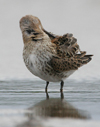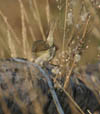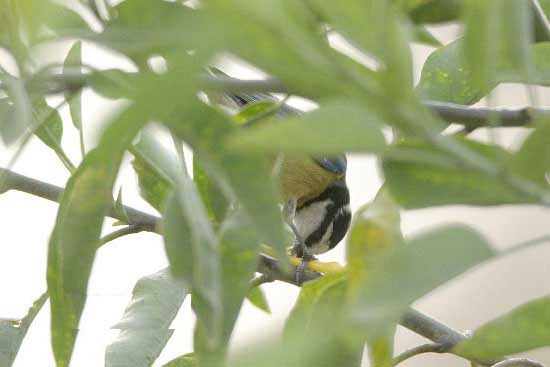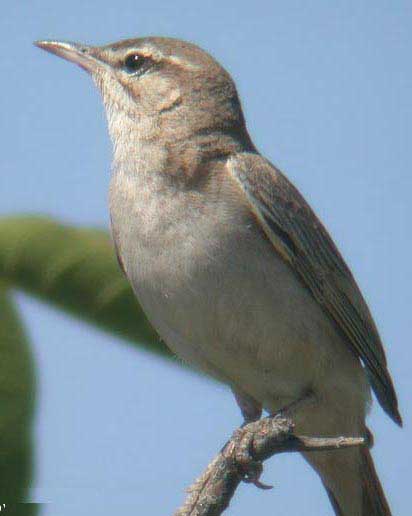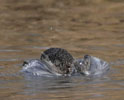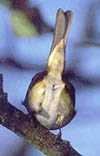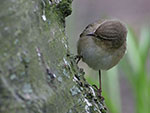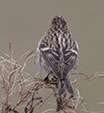|
|
|
|
STORIA DEI BIRDING CONTEST SU EBN ITALIA ANNO 2006 | |
|
SOLUZIONE MESE DI GENNAIO Le risposte esatte erano : Piovanello pancianera giovane (Calidris alpina) e Moriglione maschio (Aythya ferina). Sul limicolo vi siete persi nell'identificazione di ben 7 specie. Su tutti il Piovanello violetto ? Non può essere un Piovanello violetto perchè nell'uccello della foto sono evidenti le sfumature rossicce sul collo e sul dorso. Notare le penne arruffate del dorso a V con un disegno caratteristico e apici bianchi mentre le copritrici alari sono più uniformi e più spente. Notare anche la punteggiatura irregolare sul fianco che si perde nel collo dove si evidenzia una tinta rossiccia tipica del giovane in autunno, il becco e le zampe completamente neri. Moriglione o Moretta grigia? La sfumatura di colore tra il dorso e i fianchi non è evidente. Sulla Collins c'è una freccia che indica "back as pale as flank", cioè "il dorso è chiaro come il fianco", nella Moretta grigia il dorso è grigio, il fianco è bianco. |
Foto 1 e 2 |
|
SOLUZIONE MESE DI FEBBRAIO La 3° e la 4° foto dello Swarovski Optik Italia Birding Contest raffiguravano due specie completamente differenti. La prima foto era un Piovanello violetto (Calidris maritima) e la seconda uno STORNO ROSEO giovane (Sturneus roseus). La prima foto è stata correttamente identificata da 58 su 76 persone (76%). Le risposte sbagliate comprendevano: Voltapietre (3), Canapiglia (2), Alzavola,Chiurlottello, Albastrello, Edredone, Piovanello maggiore, Mestolone (2), Fischione, Marzaiola, Oca selvatica, Oca granaiola, Frullino Gambecchio nano. La seconda foto invece è stata una deblacle. NESSUNO, dico NESSUNO, l'ha saputa interpretare correttamente!! Risposte sbagliare : Storno (36), Pigliamosche (11), Tordo bottaccio (6), Tordo sassello (2), Merlo (3), Pigliamosche bruno, Strillozzo, Nibbio bruno, Venturone, Pettazzurro, Zigolo boschereccio, Calandra, Pettirosso, Spioncello marino, Calandro maggiore. COMMENTO: Prima foto. La foto era un po' piccola ma ingrandendola con qualunque software di elaborazione foto, l'identificazione era semplice. Il colore di fondo, viola, l'ambientazione (una pietra) suggerivano subito la possibilità che fosse un Piovanello violetto. Tutte le specie che avete indicato nessuna ha quella colorazione di fondo di piumaggio. Chi ha indicato Voltapietre ci è andato vicino per struttura e piumaggio, ma il groppone nel Voltapietre sarebbe stato chiaro e non concolore al dorso come nella foto. Seconda foto. La strage. Una prima difficoltà incontrata dai partecipanti è stata rappresentata dall'orizzontarsi correttamente a identificare il genere. E' chiaro che le dimensioni relative possono trarre in inganno, ma la struttura delle copritrici alari, le secondarie molto larghe e grandi, il corpo dell'uccello molto robusto, le zampe forti e grosse, conducevano verso uccelli di medie-grandi dimensioni come i turdidi e gli sturnidi. La combinazione di una coda corta, l'aspetto a coda di frac delle primarie che si aprono sul sovraccoda in modo caratteristico, insieme alla colorazione generale, indicavano gli storni, che in Italia, hanno due rappresentanti. Dopodichè, avranno pensato in molti, l'ostacolo era superato. Invece, dato che sono qui non per presentare foto didattiche, ma per mettervi in difficoltà con tutte le possibiltà che mi sono concesse dal concorso (tranne quella di alterare le foto) e che come primo premio c'è un binocolo Swarovski e non una caramella, vi chiedevo di sforzarvi ancora un po'. Invece siete rimasti all'evidenza della soluzione più ovvia. Riprendiamo l'analisi. Innanzitutto, non si tratta di un adulto. Depone chiaramente per un giovane dell'anno, la marginatura chiara delle penne di volo. La colorazione neutra del piumaggio che non contrasta con le penne di volo, lasciava tranquillamente andare il pensiero verso l'identificazione più scontata, cioè lo Storno comune. E' vero, guardando le guide che indicano il juv di Storno roseo caratterizzato da ali scure che constrastano con il dorso e il groppone si arriva a scartare il roseo . La Collins ad esempio, lo raffigura esageratamente chiaro e pallido. Dal vero è un po' diverso, nel senso che questo contrasto non è poi affatto così evidente http://www.homepages.mcb.net/wormwell/rcs300904.jpg. Bisognava di fronte a questo dilemma, chiedersi: può essere uno Storno comune? Il giovane di Storno comune ha in generale una colorazione più uniforme e bruna. La marginatura chiara delle giovani penne generalmente non è affatto evidente e non è aranciata Ecco alcuni 2 esempi: http://homepage.ntlworld.com/peter.raby2/Starling.JPG http://www.geocities.com/tgrey41/EuropeanStarlingJuv.jpg ma sappiamo bene che le sfumature e le dominanze di colore delle foto possono trarre in inganno, ma signori!! Cosa sono quelle pennette bruno-scuro con bordi aranciati che spuntano bellemente a livello delle grandi copritrici? Non le avete notate? Vi siete dati un'altra spiegazione? La spiegazione è che si tratta di uno Storno roseo giovane giovane che ha ancora la crescita delle copritrici mediane (manca del tutto di copr. maggiori e terziare più esterne) e che non ha una colorazione piena delle penne di volo. Non ne siete del tutto convinti? Per i San Tommaso, foto di Storno roseo juv dell'olandese Will Aahnane. http://www.birdguide.it/BC4soluzione.jpg |
 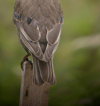
Foto 3 e 4 |
|
SOLUZIONE MESE DI SETTEMBRE La 15a e 16a foto dello Swarovski Optik Birding contest raffiguravano due gabbiani. La prima foto è stata identificata dal 44% dei 34 partecipanti, la seconda dal 47%. Risposte sbagliate: Prima foto: Gavina (2), Gavina americana, Gabbiano sghignazzante (2), Gabbiano reale (3), Mugnaiaccio (6), Gabbiano corallino (2), Gabbiano corso. Seconda foto: Gavina (10), Gavina americana, Gabbiano reale nordico (2), Mugnaiaccio, Gabbiano pontico, Gabbiano corallino, Gabbiano corso. Notare che le risposte sbagliate vertono sempre sulle stesse specie come se la foto fosse solo una. La corretta identificazione era : foto 15 GABBIANO di PALLAS (Larus ichtyaetus) foto 16 GABBIANO del CASPIO o PONTICO (Larus cachinnans). Dato l’interesse sempre maggiore nell’identificazione dei gabbiani, dopo la revisione della tassonomia dei taxa, lascio la parola a Ricard Gutiérrez, che molti di voi hanno conosciuto di persona a Comacchio in occasione del Convegno sull’identificazione sul campo di alcune specie rare e deus ex machina dell’ottimo sito Rare Birds in Spain http://www.rarebirdspain.net. Large gulls have been always a kind of nightmare for the average birder. On the contrary, some observers consider them ‘a mine’ where new findings are ready to be discovered. So they don’t leave you indifferent. Either you love them or you hate them. Since the last years discoverings in patterns of tertials, coverts, moult and the parallel development of optics and no less important, in ID articles and books, dealing with the observation, and subsequent identification, of a large gull is a bit simplier than it was formerly, given you have good views and, even better, photographic evidence to further study the case at home. Everybody also knows that sometimes a collection of characters comprising bare parts, pattern of feathers, moult and structure is needed when facing the identification of a bird. But, what happens is something so important in a gull as the head cannot be seen from the photo we’re given? Attention to other topics, first facing structure attempting to fix our problem gull either into the ‘large size’ group or into the ‘medium-little’ size group is essential. And in this case experience with the problem species (or similar) can help initially. If we keep in mind the moult cycle of the ‘small’ gulls, with 2 age-groups (such as L.ridibundus), the 3 age-groups (such as L.melanocephalus or L.canus) and the ‘larger’ gulls with 4 age groups , we can start fixing things despite we don’t see the ‘complete’ bird. Gulls reaching the WP have in adult plumage a white tail. The younger the plumage, the browner the feathers as a general rule, with plumage becoming greyer (or blacker) in the commoner species we’re used to. The bird in picture no. 2 has an extensive white underparts and from what we see part of the head as well, with a brown (at least in part) tail and a well patterned wing, black, grey and brown coloured. The underwing appears extensively white except perhaps for the lesser underwing coverts, that seem darker. The bird seems somewhat long-winged this recalling some of the medium-large species. However, when comparing to the large white body that it has, it comes to mind that these proportions are those of a large gull, from say the size of a Larus fuscus graellsii or Larus audouinii onwards. It is obvious with this pattern that we are not facing a ‘two age-group’ gull such as Larus ridibundus or L.genei, with pale outer primaries in the upperwing, not to mention other smaller gulls such as L.minutus, L.sabini, L.philadlphia, R.trydactyla or R.rosea. The patterning of the bird, with such dark colours in the wing also rule out the ‘coffee&milk’ species, the L.glaucoides, L.hyperboreus and the much rarer P.eburnea.And on the contrary, they also rule out the browner and darker Red Sea species such as L.hemprichii (that in 1w plumage would present a dark hood, not white as in our bird and it is not so bulky) or the White-eyed Gull (L.leucophthalmus), much darker and differently structured than our bird. A number of medium sized gulls do not fit neither structure (not to bulky in body size for example for such a wing length) regardless the pattern of the wing: L.pipixcan has shorter wings and a different wing pattern (plus presents a hood in any plumage); a Larus melanocephalus with such wing pattern would be a 1st winter but this species has blunter, shorter wings, it is not so bulky bodied. That would be enough but if we come to the detail of wing pattern, we should have noted a pale grey panel formed by greater coverts contrasting with both darker secondaries (such as in this bird) and very dark median and lesser coverts. The problem bird has brown edged grey greater coverts so it’s not a Med Gull. Same judgement would be applicable for the bulky but no so long-winged Common Gull and Ring-billed Gull which in any case look so large as this gull and bith have grey panels in greater coverts and, another feature, a coarsely marked underwing, not as this bird. The American Laughing gull is not so bulkier, despite being a long-winged gull, and has mared underwings and greyer flanks in its 1st winter plumage, besides being greyer overall, so it’s not the case. What do we have left? Audouin’s Gull in juvenile plumage is very dark overall and has a diagnostic underwing pattern with a white panel surrounded by two large dark bars formed by coverts and secondaries. Most of 1st year birds spend their lives away from the Mediterranean but show a mixture of already grey feathers, particularly around mantle contrasting with darker wings, not showing contrast between inner and outer primaries unlike this bird whose feathers look of the same age, all showing same wear and no sign of moult, pointing towards a 1st calendar-year bird (juvenile/1st winter). Audouin’s, beside, has the underwing showing darker edges to the coverts, thus not overall white as the problem bird, a gentlier body, it is low chested and is more ‘elegantly’ proportioned, not as this bird. So we’re left with the ‘herring gull complex’ including all the michahellis/cachinnans/fuscus etc group to deal with and to see what do we have. Facing with 1w birds of these species means assessing colours and patterns of wing feathers. Fortunately, the picture gives us both views of the upper and underwing. The combination of both points out towards the correct identification of this gull. From the colour of the bird is clear that is not one of the darker L.fuscus species that would be darker and not showing the inner primaries with such inner paler edges contrasting with the darker outer primaries and not showing that neat white underparts unlike L.marinus for example which shows also a differently patterned upperwing, with a greyer and darker almost ‘spotted’ pattern and, most importantly, greyer underwings. Same overall darker underwing pattern and should be not so marked upperwing design rule out L.argentatus as well. A rarer bird that could fit the bird pattern, particularly the whitish underwing is the L.ichthyaetus. It is large, it has a dark bar in the tail of 1st winters and some contrast between outer and innermost primaries. However it shows a dark trailing edge from below, caused by the very dark secondaries, a fact not present in our bird. We indeed have few options left. The pattern of the wing looks still familiar but it’s a bit greyer to that of our common michahellis birds. And a bit more patterned. In fact the puzzle bird is a relative to our Yellow-legged Gulls and since not so many years, it was indeed lumped with that species, now splitted into another, the Caspian Gull Larus cachinnans. This 1st winter Caspian Gull shows its diagnostic white underwing, concolorous with the body and the well patterned upperwing in which the outermost dark primaries contrast with the innermost that present a pale grey inner web, ‘the Venetian blind’. Besides it shows bicoloured greater upperwing coverts, with darker centers and pale grey wide tips and in the underwing, an overall pale looking contrasting with the darker lesser underwing coverts. The spots visible in the undertail coverts are also a feature of cachinnans. If the head would have been visible, a small head with a slender sloped front plus a rather slender bill with almost parallel mandibles would have added simplicity to the identification. But this is a game and needs some difficulty, no? |
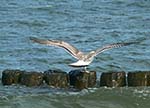 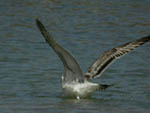
Foto 15 e 16 |
|
SOLUZIONE MESE DI OTTOBRE La prima foto era relativamente facile, in quanto nonostante che dell'animale non si vedessero nè la testa nè le zampe, offriva l'analisi quasi completa della sue ali e della sua coda. Bastava capire come fosse messo l'uccello, per evitare la trappola delle anatre (che non hanno barra caudale terminale) e dirigersi decisamente verso i gabbiani. Infatti si tratta di un gabbiano che fa abluzioni nell'acqua. Che specie di gabbiano? Le primarie appaiono bruno molto scuro e con pochissimo bianco, giusto una virgola, le secondarie appaiono brune con apici bianchi quasi inesistenti, le terziarie più chiare con margini bianchi sottili, il sovraccoda appare bianco con disegno bruno quasi a losanghe regolari, con barra terminale scura quanto le primarie. Dalle caratteristiche del piumaggio, si tratta certamente di un juvenile/1 inverno. Tra le specie papabili, ci sono i juvenile/1 inverno di Zafferano, Gabbiano nordico, il reale mediterraneo, il Mugnaiaccio. Il Mugnaiaccio (cfr. "Gulls") è la specie che si distanzia maggiormente dal gabbiano della foto, come colorazione di fondo, ha secondarie molto più chiare e terziarie con spots scuri più limitati al margine alare. Lo Zafferano nei piumaggi da juvenile/1° inv., ha primarie completamente bruno scuro, secondarie con apici più chiari e terziarie meno marezzate, sovraccoda più chiaro con timoniere centrali quasi bianche e viene escluso, il michahellis ha un pattern delle primarie e (parzialmente) delle secondarie che si accorda con quanto esposto dalla foto, terziarie con margini chiari più estesi e sfumati, ma ancora compatibili con la foto, ma sovraccoda decisamente differente, con più bianco, meno distintamente caratterizzato da disegni bruno-scuro. Un buon articolo con buone foto: http://www.surfbirds.com/ID%20Articles/YLGs1.html. (confrontate ad esempio il sovraccoda di figura 5 con quello dell'animale della foto, fig 10 e 11 per il pattern delle terziarie) Non ci rimane che il GABBIANO (reale) NORDICO che ha tutte le caratteristiche mostrate dalla foto. Seconda foto un po' più difficile anche se la scelta era ristretta a poche specie. Infatti, che si trattasse di un alcide è stato evidente a tutti tranne che a due. In particolare, il modo di tuffarsi ad ali aperte in avanti è tipico di un alcide piuttosto che di un'anatra tuffatrice (cfr: pag 194 Collins) Tutti gli alcidi con parti superiori nere (escluso la Pulcinella di mare che non ha zampe nere) potevano essere presi in considerazione, compresa l'Uria di Bruennich, che tuttavia avete scartato a priori perchè mai comparsa in Italia. Abbiamo quindi Uria, Gazza marina e Gazza marina minore. L'Uria presenta zampe che sporgono rispetto alla coda, particolare che, immaginando di ruotare l'asse della coda e di ruotare la zampa fino all'assetto di volo, non appare nella foto (la punta della zampa è appena appena oltre la coda); escludiamo così l'Uria. Il bianco sul fianco è a margini rettilinei e non deborda sopra il groppone: questo particolare assieme all'aspetto piuttosto scuro del sottoala, invece induce ad escludere la Gazza marina. Non resta quindi che la Gazza marina minore. |
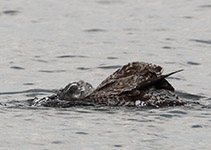 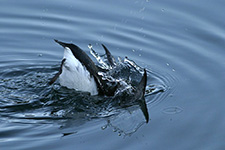
Foto 17 e 18 |
|
SOLUZIONE MESE DI NOVEMBRE
Prima foto: risposte corrette 53%. Errate : Girfalco (3), Lanario Sacro (2),
Pittima minore (2), Chiurlo maggiore, Gabbiano reale nordico, Totano moro, Piro
piro boschereccio Seconda foto : foto corrette 50%. Errate : Aquila anatraia
minore, Albanella minore, Albanella reale (3), Albanella pallida, Falco
pecchiaiolo, Aquila di Bonelli (2), Falco di palude (2), Biancone, Smeriglio,
Poiana calzata, Aquila minore |
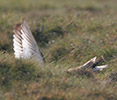 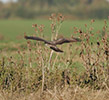
Foto 19 e 20 |
|
SOLUZIONE MESE DI DICEMBRE
Gran finale dello Swarovski Optik Birding Contest 2006. |
 
Foto 21 e 22 |
|
CLASSIFICA FINALE
LAURA e PAOLO Casali da Varese, Italia, vincono assieme (loro vivono in
simbiosi) il Birding Contest 2006 meritatamente con 18 punti su 22 !
Luciano Ruggeri - Presidente EBNItalia - |
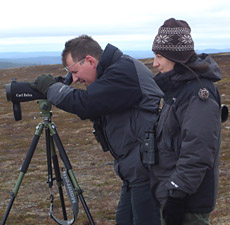
Foto vincitori |
|
Copyright © 1997-2005, EBN Italia |
